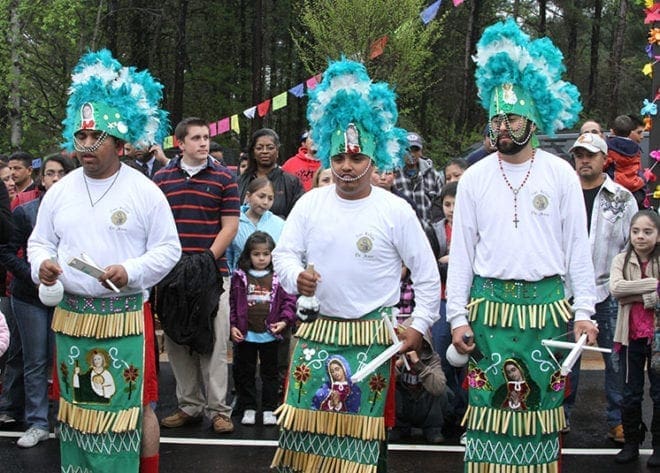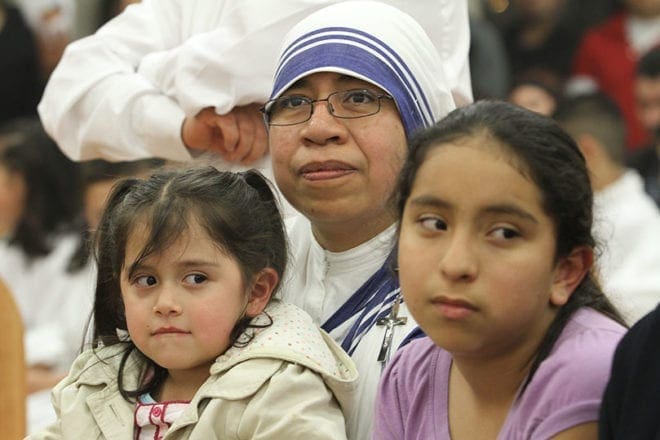Dancers and a mariachi band entertained members of the congregation prior to the Mass of dedication. Photo By Michael Alexander
Forest Park
Hispanic Mission Builds Self-Financed Church
By RUTH E. DÁVILA, Special To The Bulletin | Published April 14, 2011
A Latino mission, once sustained by Sacred Heart Parish downtown, has built its first new church, primarily from its own work and dollars. Members of San Felipe de Jesús Mission financed the building with $1 million from their own initiatives and a $300,000 loan from the archdiocese.
“It is the first and only church built from the ground up with the support of Latino immigrants in Georgia,” said Missionaries of St. Charles—Scalabrinians Father Jacques E. Fabre, assigned as administrator to San Felipe since June 2008.
The church’s most popular fundraiser has been a big hit with its predominantly Mexican population: selling tacos outside after each of the four Sunday Masses. Through taco sales, along with the second collection, San Felipe raised an average of $3,000 toward construction every weekend, Father Fabre said. Other fundraisers included cultural events, dances and raffles held throughout the year as well as private donations to the capital fund.
“Given that we work with immigrants, my focus has been to see if it would be possible to sustain a totally Latino community through their own way of doing things, which are somewhat different from American ways of doing things,” added Father Fabre, a native of Haiti.
The new church, constructed in a Spanish colonial mission style, shares a lot with San Felipe’s old church at 925 Conley Road in Forest Park. The previous church was bought from a Baptist congregation in 2002.

(L-r) Juan Rodriguez, Juan Angel Collazo and Gabriel Fuentes, members of the San Felipe de Jesus dance troupe, participate with other dancers during a prededication celebration behind the old church. Photo By Michael Alexander
The 11,200-square-foot sanctuary holds 650 people, but more than double that number attended the dedication Mass Wednesday, March 30, despite rain and limited parking. A little rain wasn’t enough to deter a community that in the early 1990s had no structure to its name. For years they would gather a few miles away, in Grant Park, to hear Mass outdoors under a shelter made of blue tarps.
Martín Pizano, a longtime member, recalled that his son would accompany a Franciscan Sister of Our Lady of Refuge, Sister Marta, around the area, ringing a bell.
“They would walk up and down the streets where they more or less thought Hispanics lived, and when you heard the bell, you knew it was time for Mass,” Pizano said.
Another original member, Herminio Pérez, remembered the baptism of his daughter, now 22, at San Felipe when she was a toddler. They joined four other families in a communal baptism Mass in the same parking lot where they celebrated the Eucharist each week.
“We all got together and decided to baptize our children in a single Mass and throw one big party as a community,” Pérez said.
Perhaps a dozen individuals met for Mass in the early days. But the fact that it was offered in Spanish—and in their own barrio, or neighborhood—laid the groundwork for what is today a thriving community. Father Fabre estimates that up to 2,500 now attend San Felipe.
Blessing In The Dark
At dusk, a colorful procession ensued to christen the new church. San Felipe’s ministries paraded floats with icons of saints and Our Lady of Guadalupe, singing Spanish hymns. Young male parishioners danced in Mexican folkloric costume in the rain.
Archbishop Wilton D. Gregory, joined by some 15 other priests, rounded the building. After a ministry leader recounted the impressive story of the mission’s roots, Archbishop Gregory cut the ribbon draped across the front door, proclaiming in Spanish: “Welcome to the new house of the Lord.”
As the doors opened, a throng poured into the dark church, though many remained outside, unable to make it through. During the rite of dedication, Archbishop Gregory accompanied Father Fabre in anointing the altar and walls along with San Felipe’s former priest, Father José Duvan Gonzalez. The archbishop called the light of Christ to shine in the church, and the first flicker of light illuminated the sanctuary.
A large crowd huddled outside the entrance, some under a small tarp. They were accustomed to standing-room conditions. In the old church, one had to arrive half an hour before Mass to get a seat, Father Fabre said. For the past six years, due to the small quarters, a total of 300 people convened in the church’s classrooms every Sunday to listen to the Mass through a sound system.
“What’s nice is that they bear that tradition,” said Father Fabre. “They’re moving forward with that history and that reality of a living community. The same community that started in Grant Park marches on—and the Lord will bless them.”

Four-year-old Margarita Taraphia, left, and 11-year-old Mariana Ornelas sit with Missionaries of Charity Sister Aracelly during the March 30 Mass of Dedication. The Missionaries of Charity assist with teaching religious education at the mission. Photo By Michael Alexander
After the church’s consecration, parishioners and visiting priests moved to a party staged under a large tent. They enjoyed food, mariachi music and dance presentations by local groups until midnight.
Lázaro Martínez Cruz, an officer of San Felipe’s finance team, said that while the construction of the church is a great feat, much work is still needed.
“We have to keep working to finish paying off the debt of the new building and then to continue remodeling the old one for multi-use functions and catechism classes,” Martínez Cruz said. “We need a lot of space, and also air conditioning, for the old building.”
Years of sacrifice have given San Felipe’s members a sense that “this is their house, our house,” Father Fabre said. In his estimation, they feel invested in the new church because they brought it to fruition through a campaign of their own design and labor.
Since June 2010, when the archdiocese granted San Felipe a construction permit, the mission has been financially independent.
“Like Pope Paul VI said: Don’t do for a person what he can do for himself,” said Father Fabre, a native of Haiti who is fluent in Spanish. “The point is not to give him everything because he is poor and an immigrant, but rather to help him to develop his talents and administer well what little he has on a material level as well as a spiritual level.”





